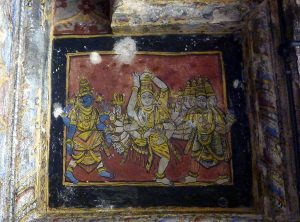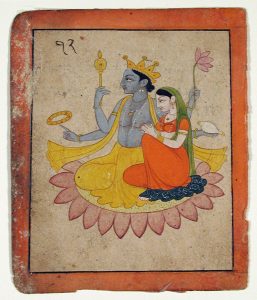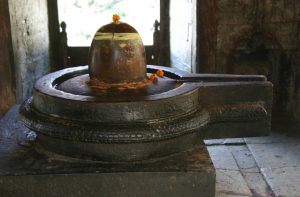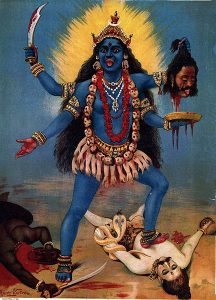9 Narrative guide: The Who’s Who of Hindu Gods
The identity of the gods in Hinduism can be quite fluid. An important principle in Indian thought from the Upanishads is that the world that we see, feel, hear, in other words, the sensory world, is illusion. The underlying reality and unity of the universe is not something that can be understood through the senses. Images and specific characteristics of the gods are temporary.
As we saw in the section on the epic tales, avatars are a manifestation of a god. For example, in the Bhagavad Gita Krishna appears in the world as an avatar of Vishnu to help Arjuna resolve his doubts about fighting. If Arjuna fights he will help restore order, a main function of Vishnu. Vishnu is the unmanifested principle of order. This means that Vishnu has no specific shape or substance, but is the ordering principle of the universe. As an avatar of Vishnu, Krishna will appear in the world. Arjuna is the human whose actions (karma) help to restore order through his interaction with Krishna, the avatar of Vishnu.
Sects in Hinduism: There are three major sects in Hinduism, based on the primary focus of worship:
- Vaishnavites: devotees of Vishnu and his two avatars, Krishna and Rama
- Saivites: devotees of Siva
- Shaktas: devotees of the Great Goddess, Devi
Brahma and the Trimurti
Brahma is the creator deity. He is depicted with four heads which symbolize the four Vedas, the four classes, and the four stages of life. His popularity in Indian myth was from 500 BCE to 500 CE. Brahma has a fluid character. He is closely associated with kingship in the Mahabharata and he appears as a divine king in Buddhist texts.
During the Puranic period Brahma became overshadowed by Vishnu. In approximately 500 CE, the Trimurti, an image of a single god with three heads, each representing Brahma, Vishnu, and Siva, was an attempt to overcome sectarianism. The point of the Trimurti is to include all three functions of god into one figure: Brahma is the power of creation, Vishnu maintains creation, and Siva destroys creation so that it may be renewed. As the female companion of Brahma, Saraswati is the goddess of knowledge, music, art and nature. In the following image from a temple at Tanjore, Brahma is in the four-headed god on the right, Vishnu is the blue god on the left, and Siva is in the center, dancing.

Vishnu
Devotee group: Vaishnavaite
The god Vishnu is the preserver and protector of creation. When the world is threatened by demonic forces Vishnu takes on the form of an avatar to restore order. He has appeared in the world as a dwarf, a boar and a fish, but his most important avatars are Rama and Krishna from the epic tales.
Vishnu is usually depicted with blue skin and four arms, each carrying a symbol representing an aspect of existence; a conch for creation, a chakra or psychic energy center for the mind, a lotus flower for liberation, and a mace for strength. Lakshmi, the goddess of wealth and beauty is Vishnu’s female companion.

Avatars of Vishnu
Rama is the avatar of Vishnu in the epic tale, Ramayana. Although Rama believes that he is an ordinary human, he is in fact an avatar. This is revealed to him at the end of the tale. In the case of Rama, his role as avatar is never clear to him until after he has gone through many challenges. In the end, Rama’s choices have all led to the restoration of order in the universe.
Krishna is the avatar of Vishnu who appears in the Bhagavad Gita, a part of the epic tale, the Mahabharata. As described earlier, the Bhagavad Gita is set on a battlefield, where the main character Arjuna is about to go to war with members of his extended family for challenging the throne. As he sits in his chariot surveying the armies, he is overcome with grief, not wanting to kill his own family. His charioteer, Krishna, who is an avatar of Vishnu, instructs him on the nature of duty and the yogic paths of knowledge or jnana; action or karma; and devotion or bhakti.
Siva
Devotee group: Shaivites
Siva is the god of destruction and of ascetic practice. In his role as the destroyer, Siva is timeless: he is always there at the end of a cycle to destroy it so that the world can be renewed.
As we saw earlier, Siva fulfills two role models for humans: the ascetic ideal of withdrawal from the sensory world to seek knowledge; and the life of the householder and sensual pleasure. In this dual role, Siva supports the different aspects of human life and aspiration. Parvati is his consort, symbolizing fertility and devotion. She is the mother of the elephant-headed god, Ganesh, the god of beginnings. Both Parvati and Ganesh are the focus of separate devotional sects. In the image below we see the family group of Siva, his wife, Parvati, and their son, Ganesh.

Material Culture: the Lingam
Siva is often represented by the lingam (a phallus) which symbolizes his creative energy. Sometimes the lingam is accompanied by the yoni, a symbol of the female creativity. In the following image we see both the lingam as a smooth column and the yoni, which is represented by the circular container.

The Goddess
Devotee group: Shaktas
The Great Goddess or feminine divine principle of the universe is Shakti. Shakti can take many forms: gentle, life-giving, or even fierce. The Divine mother is referred to as Devi or Shakti. The devotion to the Great Goddess developed in the fifth century CE from the Purana literature. As consorts of the gods Siva and Vishnu, the goddesses seem secondary. But as bhakti yoga developed, this relationship reversed. In later stages, the goddess has control as Shakti, the creative power of the god, and is the active one.
Durga, the consort of Siva, illustrates the active side of the relationship. She balances the intelligence of Siva with her creative power that activates primal matter. She is seen as the female manifestation of Brahman who created the world of samsara, the round of birth, death and rebirth.
A fierce manifestation of the goddess is Kali, the dark one. Her role is to destroy evil. She wears a belt of skulls and carries a three-pronged weapon (trident). Although her image is fierce, she is beloved as a protector.

